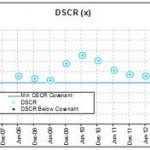Mortgage DSCR or the Debt Service Coverage Ratio is used to determine whether or not a commercial mortgage can be approved, that is to say, it helps in the determination of its approvability. The DSCR plays the most important role in the underwriting process of a commercial real estate loan.
 This ratio is used in the analysis of the debt amount that can be supported by the property-generated cash flow. In other words, the calculation of DSCR can be done by dividing the property generated net income by commercial mortgage payment.
This ratio is used in the analysis of the debt amount that can be supported by the property-generated cash flow. In other words, the calculation of DSCR can be done by dividing the property generated net income by commercial mortgage payment.
DSCR and Debt-to-Income (DI) Ratio
The DSCR is equivalent to the DI Ratio (residential lending) in commercial mortgage lending. The value of the income and expenses used in the calculation of the DSCR ratio is derived from the commercial property.
The DSCR and Commercial Mortgage Lending
The denial of a commercial loan depends on a variety of factors. The fact that a property may not meet the minimum requirements of a commercial lender stands as one of the reasons behind the denials. It is important that you understand how the calculation of the DSCR is done by a commercial mortgage lender. The information you gain comes very handy when you make an application for a commercial conduit loan, real estate loan or apartment loan.
There is a very common misconception that runs riot among the borrowers. This happens when they make applications for commercial mortgage loans. The misconception is all about the bank or commercial lender using the property expenses in the calculation of the Net Operating Income (NOI). The actual expenses in addition to the extra holdbacks like vacancy, off-site management, replacement reserves, repairs and maintenance are used by the commercial mortgage lenders.
There are several reasons for the commercial lenders to add all these numbers to the expenses. The reasons include a management fee holdback in case the borrower defaults, vacancy factor in case a property loses tenant, cost rises etc.
Debt Service Coverage Ratio (DSCR) – Calculation
There are several inputs made by a commercial mortgage lender in the calculation of DSCR for a commercial loan request. The inputs include the gross rents, other incomes, effective gross income, real estate taxes, property insurance, repairs and maintenance, pest control costs, janitorial costs, utility costs, site management reserves and replacement reserves.
The inputs made will help in the calculation of the NOI. You should proceed with the calculation of the total property debt service once you’ve calculated the NOI. You can also go with just determining the commercial mortgage loan payment, which comprises nothing but the principal and interest. The insurance and taxes are not to be included as they are part of the property expenses.
The calculation of the DSCR is a very simple one. It involves a division of the NOI by the commercial mortgage loan payment.
The new commercial lenders are offering global DSCR based commercial real estate loans. The global DSCR is calculated by the combination of property and personal income and expenses. This makes way for a property that comes with a weak cash flow. A low-cap property is also possible because of this. All of these are to qualify for a commercial only if the borrower comes with an extra income to make a successful combination or a possible addition to the property’s NOI.
Get your own authority blog site and get your message out to the world.
Like, comment and share below.

Pingback: Role of Debt Service Coverage Ratio in Commercial Mortgage Lending | caribbeanmortgageloans